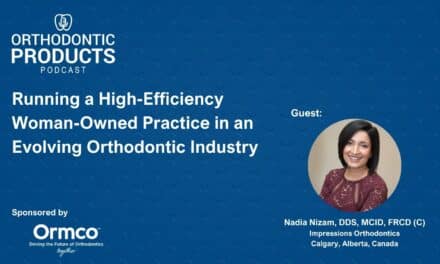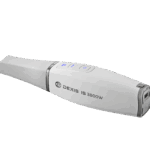Summary: This podcast episode explores how orthodontic practices can improve their employee onboarding process. Guest Cassie Kellner, founder of Everbloom, discusses the challenges of training new and experienced hires, the need for concise training materials, and the role of digital tools in streamlining the process.
Key Takeaways:
- A structured onboarding process helps retain employees and reduces inefficiencies in training.
- Standard operating procedures should be clear, concise, and supplemented with short training videos.
- Digital tools like Trainual allow practices to centralize training materials, track progress, and update staff efficiently
In this episode of the Orthodontic Products podcast, host Alison Werner speaks with Cassie Kellner, founder of Everbloom, an orthodontic consulting firm. With over 20 years of experience in the orthodontic field, Kellner discusses why orthodontic practices should reassess their approach to onboarding new employees. The conversation explores the challenges of training both inexperienced hires and seasoned professionals transitioning from other practices, as well as the role of digital tools in streamlining training processes.
The Need for a Structured Onboarding System
Kellner highlights the importance of moving away from the outdated “sink or swim” approach to onboarding. She points out that a lack of structured training can lead to frustration, reduced retention, and inefficiencies within the practice. New employees with no prior orthodontic experience require a different training approach than those with industry experience. While inexperienced hires provide an opportunity to be trained from the ground up, seasoned professionals may resist certain protocols because they are accustomed to different workflows. A well-organized onboarding process can help integrate both types of hires into the practice effectively.
Modernizing Onboarding with Digital Tools
A critical part of improving onboarding, according to Kellner, is simplifying standard operating procedures (SOPs). Many practices have lengthy onboarding documents that are rarely referenced after hiring. She recommends replacing dense paragraphs with concise bullet points and incorporating short training videos to make the information more accessible. Digital platforms, such as Trainual, offer a way to centralize onboarding materials, track training progress, and update staff on procedural changes in real-time. By adopting these tools, practices can ensure consistent training while reducing the burden on team leads.
Lessons Learned from This Podcast
- A well-planned onboarding process reduces turnover and helps employees feel more confident in their roles.
- Onboarding should be adaptable, providing structured guidance for both experienced hires and those new to orthodontics.
- Digital tools can make training more efficient, ensuring consistency and easy access to updated protocols. OP
-
Podcast Transcript
Alison Werner (00:06)
Hello and welcome to the Orthodontic Products podcast. I’m your host Alison Werner. On this episode, we’re going to talk about why you should rethink your onboarding approach. And to do that, I spoke with Cassie Kellner last fall. Cassie is the founder and owner of Everbloom, an orthodontic consulting firm. She has over two decades of experience in the orthodontic field, starting as a team member before turning to consulting, lecturing, and working as a practice coach. Here she talks about the differences between onboarding an employee with no orthodontic experience and a veteran coming from another practice, why your onboarding
documents are probably longer than they should be, and how to use video and other tools to build a training resource library for your whole team. Here’s our conversation.
Alison Werner (00:45)
welcome back again.
Cassie Kellner (00:47)
Thanks for having me. This is so fun.
Alison Werner (00:50)
I know. All right. So we’re going to get a little personal here. So to start out, I’d love for you to share your experience as a team member. Can you talk about what, if you can go back, talk about what it was like when you started in your orthodontic office and your onboarding experience.
Cassie Kellner (01:03)
Yeah, let’s go back.
Yeah, so it’s 20 years this year that I started in an orthodontic practice. you know, well, first of all, I’ll say this, I answered a Craigslist ad, which that ages me, right? And I started, I worked for Rick McLaughlin in San Diego, who is an absolute gem of a human.
Alison Werner (01:13)
Okay.
well, yeah.
Cassie Kellner (01:35)
He is in, it was a teaching practice, but because I didn’t know much and I didn’t understand orthodontics, right? I started this practice and really I started as a records technician just to kind of catch my bearings and understand and quickly moved into the clinic. So I then became a chair side assistant in his practice.
Alison Werner (01:54)
Okay.
Mm -hmm.
Cassie Kellner (02:05)
And it was incredible. There were trainers and there were clinical leads that were doing the work. But the reality is, 20 years ago, it was like, here’s what we do and here’s your chair. And now you can get started, right? And so I think that for years and years, and to nobody’s fault, there’s
Alison Werner (02:25)
Yeah.
Yeah.
Cassie Kellner (02:33)
There’s, this week, the swim or swim approach was the norm. It was the absolute norm and either you could cut it or you could not. And I remember I actually got hired with somebody else and they let her go within the first four weeks because like she just couldn’t cut it. And I was like, my gosh, is that gonna happen to me? I was so young and new and it didn’t, thank God. But you know, I, it was,
Alison Werner (02:38)
Yeah, agree.
Mm -hmm.
Okay Yeah
Mm -hmm.
Yeah.
Cassie Kellner (03:02)
the sink or swim and I feel and I’m excited to talk about this too, you can no longer do that. And so the sink or swim is how I learned. There wasn’t a lot written out. There wasn’t a lot for me to review or to see. You got to see it maybe one time and then you were in there and it was like trial and error to work on patients sometimes.
Alison Werner (03:11)
Mm.
Yeah.
Yeah.
Cassie Kellner (03:31)
I believe that teams now, 20 years later, they deserve more and there are many more tools now for us to use to be able to do that.
Alison Werner (03:33)
Mm -hmm.
Yeah. Yeah.
Okay. So before we go any further, what should be the goal of onboarding?
Cassie Kellner (03:50)
Retention. I mean, we want, right? We want our people to slay. Yes. I mean, we find these wonderful people and, by the way, and again, this is nobody’s fault, but what’s happening is maybe somebody’s leaving abruptly or we hired someone because we want to be a little bit overstaffed and then all of sudden we lose one or two team members or something happens in somebody’s life and they have to go out on a
Alison Werner (03:51)
Yeah, would think so, yeah. Especially right now. Yeah.
Mm -hmm.
Cassie Kellner (04:18)
on an unexpected leave. And now we have these team members who have been promised training. They’ve been promised that we will walk them through everything in our practice. But now we just need the people to get in there and see the patients and we’re throwing them to the wolves. We’re going back to the sink or swim approach. And we may even have the resources to train them, but now we don’t have the time.
Alison Werner (04:36)
Hmm.
Mmm.
Right.
Cassie Kellner (04:45)
And
so, you know, time is everything. It’s like the number one thing I hear in practices when I go in or work with them, it’s like, yeah, we love all of this, but we don’t have time to do this. And so while that is true, it’s also up to them to be able to build in the time. I talk about this often, but you know, the number one goal to onboarding is to eliminate as much of the gray area as possible and to retain.
Alison Werner (04:56)
Mm
Cassie Kellner (05:14)
retain, retain, retain, the more they know about your practice and how to do these things from admin to clinical to lab processes, know, the more they want to stay, you know, they understand how to do it. They feel secure in their job, in their career.
Alison Werner (05:15)
Yeah.
Mm
Yeah.
Can you talk about how on is there a difference between onboarding a new employee?
and an experienced employee. And by new employee means someone like who is coming out of maybe a completely different field, like was working in a hairdressing office the week before and now is coming into an ortho office because that is happening because hiring is an issue right now or staffing is an issue right now. But then you’ve got the employee who maybe is jumping to a different practice after 20 years. What does that onboarding experience look like?
Cassie Kellner (06:04)
Well, it’s interesting. mean, we could do whole other podcast on the benefits of hiring somebody with no experience and the benefits of hiring somebody with a ton of experience because those are dramatically different, right? I would say hiring somebody, they’re in two separate buckets, but there is quite a bit of overlap because hiring somebody without any experience, they get to learn your way from the minute they walk in that practice.
Alison Werner (06:10)
Mmm.
Okay.
Mm -hmm.
Yeah.
Okay.
Mm -hmm.
Cassie Kellner (06:31)
You know, there’s a phrase that I love hate in ortho, which is, well, this is great, but in my last practice, we would. And so they’re not, that experienced person is kind of pushing back against some of the things that you’re doing because they’ve always done it this way for the last 15 years. But I would say this, you you’re inexperienced, you get to mold them. You get to teach them your ways, your verbiage.
Alison Werner (06:35)
You
Mmm.
Mm -hmm. Right. Yeah.
Cassie Kellner (07:00)
You know, you get to start from scratch. The experienced team member is much faster. They come up to speed much faster because they understand orthodontics. And so they understand everything that you’re telling them, ChairSide. They may do it in slightly a different way, but we can always train them to do it our way. They go through that onboarding process much faster than somebody who has.
Alison Werner (07:15)
Yeah.
Mm
Cassie Kellner (07:27)
very little experience. So I think there’s benefits. I think there’s benefits to both.
Alison Werner (07:28)
rate.
Okay. You talked a little bit before about some of the problems with onboarding right now. The big one is time. That’s what’s creating some of the problem. Can you talk a little bit more? Because you’ve now been working as a consultant for almost a decade. What are you seeing when you go into a practice? What are you seeing that’s right in terms of onboarding? And what are you seeing in terms of what’s wrong?
Cassie Kellner (08:01)
Yeah, what’s right is actually having SOPs. So standard operating procedure for anything in your practice. That’s what’s right. Here’s what’s tough. When you have these SOPs, you haven’t touched them in seven years and somehow this printed PDF is like on the floor of somebody’s car. They had good intentions on reading it, but you know, they’re not really gonna go in and read 72 pages of your onboarding manual.
Alison Werner (08:23)
huh.
Cassie Kellner (08:30)
It’s just in 2024, you had really good intentions 10 years ago. It’s just not, it’s not going to happen anymore. But here’s the good thing. You’re already one step ahead because you’ve written out these SOPs. All we have to do now in 2024 is simplify them. You know, my recommendation for anyone who’s starting to write out SOPs is get rid of the fluff. Like make them as clear and concise as humanly possible.
Alison Werner (08:36)
Mm
you
Mm
Mm
Cassie Kellner (08:58)
We live in bullet format, eliminate the paragraphs. Nobody’s reading that. Nobody’s reading the paragraphs in here. It has to be short, right? We live in like this scroll world. It has to be short and sweet. And so the good news is if you have the manual, dust it off and simplify it. If you don’t have anything, then you get to start from scratch with starting to simplify your SOP. So I would say,
Alison Werner (09:05)
True. Yeah.
Cassie Kellner (09:27)
to anybody out there, start, just start, create a list of SOPs to create and start creating them. The other layer to this is video, right? Creating training videos. Unfortunately, we again live in this scroll immediate gratification world and…
Alison Werner (09:41)
Mm.
Cassie Kellner (09:54)
we like to have very short, clear, and concise videos. know, a lot of practices have, through their management software, they have videos in there that are for training purposes for their patients. They can also use those to train their team members. So if I come in with no experience and you tell me to put on a class two elastic, I’m like, yes, okay. But I have no idea.
Alison Werner (09:59)
Mm -hmm
You
Cassie Kellner (10:23)
what class two means. So there’s resources out there for practices. You don’t have to reinvent the wheel here, you know, but I would say, you know, be clear and concise, have written SOPs, remove the paragraphs, keep your training videos under two minutes. I met with an orthodontist and we were getting started, and I’m gonna talk about this too, but we were getting started on building out onboarding processes.
Alison Werner (10:23)
Yeah.
Yeah.
Mm
Cassie Kellner (10:52)
And what he told me, I had such a moment here, what he told me was, so I have new team members and I don’t have any video, video training or SOPs. And what these new hires were doing, they were about 20, 21, 22 years old. They were so eager to learn. They went on YouTube themselves and started to search how to bond, I’m making this up, how to bond a lingual retainer. So now they’re like, this is how I do it.
Alison Werner (11:07)
Mm -hmm. Mm -hmm.
Cassie Kellner (11:21)
Here’s the problem, every practice does it so differently. They use different products, they use different techniques. And so if you have team members that are eager, but you don’t have anything to deliver, they’re going to, I mean, everything is on our phones, right? They’re going to find it somewhere else. And unfortunately, it may not be your process. So, you know, just start somewhere. If you have things, update them. If you don’t,
Alison Werner (11:33)
Yeah. Mm hmm.
Mm
Cassie Kellner (11:49)
create a list and get started.
Alison Werner (11:52)
Who should be tasked with building kind this onboarding resource library?
Cassie Kellner (11:59)
good question. you should have most teams. And by the way, if you’re a very, very small team and you’re listening to this and you don’t have a clinical lead, that’s OK. But most teams should have a clinical coordinator, clinical lead. they can, you can, if you have a smaller team, I typically say your clinical lead and your clinical trainer can be the same person. If you have a very large team, so I would say five plus chairs.
Alison Werner (12:23)
Okay.
Mm -hmm.
Cassie Kellner (12:28)
right in
your clinic, you should have a designated trainer for your practice. They should be writing out these SOPs and everyone on your clinical team should be in charge of creating training videos. And the reason I say that is because you may have an assistant who loves to
Alison Werner (12:32)
Okay. Okay.
Mmm.
Cassie Kellner (12:52)
to bond appliances. And you may have another assistant who’s like, that is not for me, but I love Invisalign. I love doing aligners. Great, well then divide and conquer and you assign this to that person and that to, you know, and the other thing to the other person in creation, from a training perspective, you have to be careful on who your trainer is. Trainers have to have patience.
Alison Werner (12:55)
Yeah.
huh.
Mm.
Yeah.
Mm
Cassie Kellner (13:19)
They have to be willing to answer the same questions over and over again. They have to be able to move quickly and trainers also have to be willing to let people make mistakes and ask questions because if they don’t and this happens a lot because orthodontic practices are quick, right? People typically will jump in and just do it for you. And if you’re constantly doing that, then people are never learning.
Alison Werner (13:22)
Mm -hmm. Yeah.
Yeah.
Hmm.
Cassie Kellner (13:49)
So
I do recommend that you have designated trainers, admin trainers, clinical trainers, lab trainers in your team that are not only doing hands -on training, but they are starting to create these resource boards and libraries for your team as well.
Alison Werner (14:06)
Well, in these materials, this kind of resource library for the onboarding, it can also be used for team members as new things come available or new techniques or new products and you need to train everybody. The same information is still valid, is valid for your new employees too and can just go in that onboarding center. Yeah. So are there any tools out there that you think can be beneficial to the onboarding process?
Cassie Kellner (14:16)
Absolutely.
Absolutely. Yeah.
I mean, there’s a number one tool that I live by. There’s a tool called Trainual. It’s like a play on training and manual. It is not, I wish I created it, it is not my product, but it is a product that I use. I have become a certified coach through them. So I build out onboarding playbooks through within Trainual. It is…
Alison Werner (14:37)
Yeah.
Okay. Okay.
huh. Okay.
Cassie Kellner (14:58)
Brilliant. get so it doesn’t matter the role in your practice. You could build an onboarding for a treatment coordinator You can build onboarding for a scheduling coordinator. You can build onboarding for clinical or lab lead, right? And so not only it’s is it SOPs and and it’s interactive with videos. It’s digital So there is no more PDF on the floor. There’s no more PDF scrunched in somebody’s locker
Alison Werner (15:11)
Mm
Yeah.
Cassie Kellner (15:28)
You know, it is clear and concise and it’s manageable. You also as leads can view subject manner. So you know that somebody has completed a subject. You know that you can group individuals. You know what people are working on. You can embed quizzes and assessments to really gauge where people are. And here’s my favorite piece, even though there’s a lot of good pieces.
Alison Werner (15:28)
Mm
Mm
Mmm.
Cassie Kellner (15:56)
Like you just said, Alison, when you have a new SOP or let’s say you update a process, we don’t like this bonding material anymore, we’re using this now and this is how we’re doing it or we’re not using this report anymore, we’re gonna use this report to run this, there’s a notify button. So if you change an SOP, you click the notify button and it blasts it out to your entire team, they’re like.
Alison Werner (16:04)
Yeah. All right.
Mm -hmm.
okay.
Cassie Kellner (16:22)
Hey everyone, we’ve made a massive change and we want all of you to be able to check this off. So, know, essentially just go digital. Go digital so that you can manage what people are doing. Videos and written SOPs are absolutely the way to go. That’s not gonna eliminate. That’s not going to eliminate the human trainer interaction. You still have to show people what to do and you know, but if you have these three elements,
Alison Werner (16:45)
Yeah, right.
Mm -hmm.
Cassie Kellner (16:52)
I promise you, I’ve seen it, you will retain longer. Your team will be happier if you create a true onboarding process for your team.
Alison Werner (17:05)
All right, what’s your kind of last words of wisdom on onboarding that you want our audience to take away?
Cassie Kellner (17:13)
Honestly, just start. Start somewhere. know, I… September, this is actually really good. So when anybody ever hits the month of September, everyone knows. You know, it’s typically in orthodontics when you’re in September, you feel the lull. Like right when school starts, you feel your mornings are a little less chaotic and hectic. Have a plan.
Alison Werner (17:32)
Mm -hmm.
Yeah.
Cassie Kellner (17:40)
You know, build out what you actually want to fill in. And it’s ongoing, forever. You know, all of this stuff is always changing. know, build out templates so your team can just plug and play these SOPs. If somebody has a question, they don’t know what to do with something very specific in your practice, and then they find the answer and it’s like a magical moment, have them write it out.
have them do a screen record. You can be creating SOPs throughout the day. As people go through this on admin days or non -doctor days, as leaders and trainers, start somewhere. Create a list of SOPs that you want to have for your practice. start with 10, if you have nothing, start with 10 basic, right? For each role, it is really, really important because
In my opinion, you cannot truly scale your practice if you do not have your processes written out and you cannot onboard without written out and training processes.
Alison Werner (18:51)
Yeah.
One more question, because it just came to me. How long should the onboarding process go for a new employee?
Cassie Kellner (18:54)
I love this.
this is a great question. So, okay,
I will say this. Everyone wants it like we want it immediate, right? And I typically say there’s always a 90 day onboarding, always, no matter what. Now, that does not mean your team will be fully trained by 90 days, right? We are just giving them as much information and training them in the first 90 days
Alison Werner (19:06)
Yeah.
Okay, okay.
Mm -hmm.
Cassie Kellner (19:28)
One, to see if they like us and two, to see if we like them. And this is really working. And then we always extend that to the first six months. So the reason why I say onboarding and making sure that you have checklists and using a tool like Trainual is to make sure that we’re not only keeping the new hire accountable, but we’re also keeping the trainers accountable.
Alison Werner (19:30)
Mm -hmm.
Okay.
Mm.
Cassie Kellner (19:54)
Because they can go, well, wait, I thought we went over that and we’re a year in and we’ve never touched on this process or how to do something, right? So you’re always going to create a 90 day onboarding. You’re going to extend it by six months after that as more of a resource, right? But I would say most team members are not fully comfortable for the first year in an orthodontic practice. So I would encourage people to give it some time.
Alison Werner (20:02)
Right. Mm -hmm.
Mm -hmm.
Okay.
Okay, all right. Well, Cassie, thank you so much again for joining me. And if anybody is interested in learning more or working with you, where should they go?
Cassie Kellner (20:35)
They can go to discovereverbloom .com and there’s plenty of things that they can navigate through on there, but they’ll search for trainual you all specific to this topic.
Alison Werner (20:45)
Okay, and that’s T -R -A -I -N -U -A -L. Okay, just wanted to make sure. All right, great. Thank you so much, Cassie.
Cassie Kellner (20:48)
You got it, you got it.
Yep.
Thank you.













